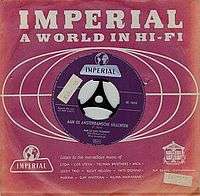Aan de Amsterdamse grachten
"Aan de Amsterdamse grachten" (Dutch pronunciation: [ˈaːn də ʔɑmstərˌdɑmsə ˈɣrɑxtə(n)]; "At the Amsterdam canals") is a Dutch song by Pieter Goemans. It was written in 1949 but not recorded until 1956, and many times more since then. It is one of the standard songs celebrating the city of Amsterdam, and one of the best-known and most popular songs in the Netherlands.

Structure and content
The song is a waltz, in 3/4 measure.[1] Typical accompaniment is the accordion. The first verse recounts a childhood experience in the house of the grandparents, a house now occupied by other people and partly converted to office space. The second explains that after having traveled widely the speaker still longs to return to the city "on the Amstel and the IJ". A transitional verse suggests that the trees, high above traffic, and the boats on the water are unchanged. According to the refrain, the speaker has given his heart to the Amsterdam canals; Amsterdam fills his thoughts, and nothing could be better than to be an Amsterdammer.[2]
History
heb ik heel mijn hart voor altijd verpand.
Amsterdam vult mijn gedachten,
als de mooiste stad in ons land.
Al die Amsterdamse mensen,
al die lichtjes 's avonds laat op het plein.
Niemand kan zich beter wensen
dan een Amsterdammer te zijn.
("To the Amsterdam canals I have given my heart for ever; Amsterdam fills my mind as the most beautiful city of our country.
All those Amsterdam people, all those lights late at night on the square; no one could wish for anything better than to be an Amsterdammer")
Goemans was inspired to write the song in 1949 while walking across the bridge where the Prinsengracht and the Leidsegracht intersect.[3] It wasn't supplied with sheet music and recorded until 1956, when an arrangement was written by pianist Dick Schallies (then a member of the Metropole Orkest) since (Schallies explained) Goemans couldn't write music. Schallies denies rumors that Enrico Neckheim was responsible for the music.[3] Goemans published the song under a pseudonym, Peter Shott;[4] he was a diplomat's son and his father allowed him to be associated with the popular music industry only if he did so under an assumed name.[5]
Henk Visscher, singer as well as guitar and bass player with Johnny Kraaijkamp, was the first to sing and record the song,[6] though other sources have Kraaijkamp sing it first, in the Café de Paris near the Leidseplein.[7] In 2006, Visscher, a friend of Goemans from the cafe, explained that he had been asked to record a demo for the song the morning after Goemans and Schallies had finally put music to the lyrics, with Schallies playing piano. Goemans had wanted Kraaijkamp, but knew better than to call him early in the morning; he called Visscher, since he did not drink.[3]
The first recording that was released was made in 1956 by singer/soccer player Hans Boskamp in a duet with his wife Nan;[3] the spelling on that recording is still the old-fashioned "Amsterdamsche". A page dedicated to the song on the web site of the Amsterdam City Archives plays that first released recording. Other notable artists of the 1950s and 1960s to record the song include Tante Leen.[5]
Of all renditions Wim Sonneveld's (1962) is probably the best known.[3] It was covered by foreigners as well, including Belgian singer Louis Neefs,[5] and by experimental jazz musician Willem Breuker.[8] Recent versions were made by Huub van der Lubbe en André Rieu.[9]
Legacy
Goeman's ashes (he died in 2000) were spread over the Prinsengracht. A plaque is affixed to the bridge, commemorating the place of inspiration for the song, and in 2008 the bridge was named for him.[7]
The annual Prinsengrachtconcert is traditionally closed with a (classical) rendition of the song.[10] The carillon of the Westertoren plays the song every half hour on Tuesday; on a list of the top 100 Dutch songs compiled by Amsterdam newspaper Het Parool the song occupies first place.[5]
References
- Straatman, Franz (22 August 1998). "Zingend door de gracht". Trouw (in Dutch). Retrieved 12 May 2013.
- Over de stroom: liedbundel voor kinderen van negen tot negentig jaar (in Dutch). Christofoor. 2006. pp. 34–45. ISBN 9789062382354.
- "Amsterdams lijflied 7: rond en over het water". Het Parool (in Dutch). 7 September 2011. Retrieved 9 May 2013.
- Heijden, Chris van der; Andree, Vera (2006). Momenten van herinnering: Nederland na 1945. Fontaine. pp. 36ff. ISBN 9789059561908.
- "De Amsterdamse grachten" (in Dutch). Amsterdam City Archives. Retrieved 9 May 2013.
- "Amsterdams lijflied: de finale". Het Parool (in Dutch). 5 October 2011. Retrieved 9 May 2013.
- "Brug voor componist Pieter Goemans". AT5 (in Dutch). 6 June 2008. Retrieved 9 May 2013.
- Buzelin, Jean; Buzelin, Françoise (1992). Willem Brenker (in Dutch). Editions Parenthèses. p. 211. ISBN 9782907224246.
- Oitmann, Pierre (9 April 2013). "Rev. of André Rieu, Rieu Royale". NU.nl (in Dutch). Retrieved 12 May 2013.
- Swanborn, Peter (25 August 2003). "'Brahms moet ook kunnen' zolang er rosé is". de Volkskrant (in Dutch). Retrieved 9 May 2013.
External links
- Wim Sonneveld on YouTube singing "Aan de Amsterdamse grachten"
- Tante Leen's version on YouTube